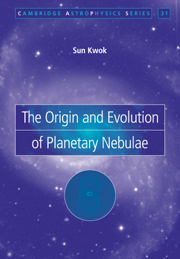Book contents
- Frontmatter
- Contents
- Preface
- 1 History and overview
- 2 Ionization structure of planetary nebulae
- 3 Nebular line radiation
- 4 Nebular continuum radiation
- 5 The neutral gas component
- 6 The dust component
- 7 Observations of the central star of planetary nebulae
- 8 Morphologies of planetary nebulae
- 9 Problems and questions
- 10 Asymptotic giant branch stars – progenitors of planetary nebulae
- 11 Evolution of the central stars
- 12 Formation of planetary nebulae
- 13 Dynamical evolution of planetary nebulae
- 14 Protoplanetary nebulae – the transition objects
- 15 Evolution to the white dwarf stage
- 16 Distances to planetary nebulae
- 17 Comparison between evolutionary models and observations
- 18 PN in the galactic context
- 19 Chemical abundances
- 20 Planetary nebulae in other galaxies
- 21 Concluding remarks
- References
- Appendix List of symbols and abbreviations
- Subject index
21 - Concluding remarks
Published online by Cambridge University Press: 04 November 2009
- Frontmatter
- Contents
- Preface
- 1 History and overview
- 2 Ionization structure of planetary nebulae
- 3 Nebular line radiation
- 4 Nebular continuum radiation
- 5 The neutral gas component
- 6 The dust component
- 7 Observations of the central star of planetary nebulae
- 8 Morphologies of planetary nebulae
- 9 Problems and questions
- 10 Asymptotic giant branch stars – progenitors of planetary nebulae
- 11 Evolution of the central stars
- 12 Formation of planetary nebulae
- 13 Dynamical evolution of planetary nebulae
- 14 Protoplanetary nebulae – the transition objects
- 15 Evolution to the white dwarf stage
- 16 Distances to planetary nebulae
- 17 Comparison between evolutionary models and observations
- 18 PN in the galactic context
- 19 Chemical abundances
- 20 Planetary nebulae in other galaxies
- 21 Concluding remarks
- References
- Appendix List of symbols and abbreviations
- Subject index
Summary
In this book, we have addressed three aspects of PN research: radiation mechanisms, evolution, and applications. We have discussed the various physical mechanisms that are responsible for the emission of radiation from PN, and how different techniques (imaging, photometry and spectroscopy) in the radio, submillmeter, infrared, optical, ultraviolet, and X-ray can be used to probe the physical conditions in different parts of the nebulae. The wealth of data obtained through multi-wavelength observations have served as laboratories for the testing of radiation theories as well as for atomic and molecular physics. The discoveries of new phenomena such as forbidden lines and unidentified infrared features have stimulated the laboratory spectroscopy of atomic and molecular species.
The central stars of PN are hot and luminous objects. Although most of the starlight is in the form of high-energy UV photons, the nebulae are able to intercept these photons and downgrade them to visible wavelengths. Through photoionization, the radiative energy of the star is transferred to the kinetic energy pool of the gaseous nebula, which then emits low-energy line and continuum photons through the processes of recombination and collisional excitation. As the result, PN become bright visible objects and can be detected at large (cosmological) distances. For nearby PN, it is possible to obtain very high-quality spectra which allow for the accurate determination of chemical abundances and kinematic structure of the nebulae.
- Type
- Chapter
- Information
- The Origin and Evolution of Planetary Nebulae , pp. 221 - 222Publisher: Cambridge University PressPrint publication year: 2000



